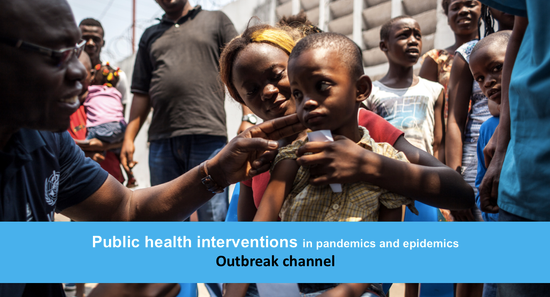
The 21st century has witnessed changes - travel and trade, urbanization, environmental degradation and other trends that increase the risk of disease outbreaks, their spread and amplification into epidemics and pandemics. At the same time, the science and knowledge around infectious hazards are constantly evolving. This introductory level online course will guide you through the new landscape by providing information and tools you need to better manage disease outbreaks and health emergencies. Materials have been originally designed for WHO African region purposes and have therefore references to Africa more than other continents.
**Please note: This course was developed in 2017. For the latest updates, please refer to the relevant health topics on the WHO website.
Language: English
English
Health topic
Course information
La version française de ce cours est disponible sur: https://openwho.org/courses/interventions-sante-publique
Overview: The 21st century has witnessed changes - travel and trade, urbanization, environmental degradation and other trends that increase the risk of disease outbreaks, their spread and amplification into epidemics and pandemics. At the same time, the science and knowledge around infectious hazards are constantly evolving. This introductory level online course will guide you through the new landscape by providing information on interventions needed to better manage disease outbreaks and health emergencies. Whether you work at the global, regional or country level, we hope that this course will update your knowledge on infectious hazards management and strengthen your access to tools, resources and expertise across WHO. We hope that you will be encouraged to participate in a discussion board to gain more in-depth knowledge from other experts working in this field.
Learning objective: Update your knowledge on infectious hazards management and the interventions needed to better manage disease outbreaks and health emergencies while strengthening your access to tools, resources and expertise across WHO interventions.
Course duration: Approximately 3 hours.
Certificates: A Confirmation of Participation is available to participants who complete at least 80% of the course materials.
Course contents
Risk communication for Influenza:
Risk communication is a core public health intervention in any disease outbreak and health emergency. It refers to the real-time exchange of information, advice and opinions between experts, officials and people who face a threat to their well-being, to enable informed decision-making and to adopt protective behaviors. This introductory presentation is adjusted in particular for influenza events. The principles apply to any outbreak and health emergency context.Pandemic Influenza Preparedness Planning:
Pandemic influenza is an acute viral disease of the respiratory tract. Pandemic influenza occurs when an influenza virus that was not previously circulating among people, and to which most people have no immunity, emerges and transmits among people.Operationalizing Emergency Response:
The WHO Health Emergencies Programme (WHE) focuses on health emergencies and outbreak response. This presentation gives an introduction to emergency management, WHO’s role in emergencies, the emergency response framework and the incident management system.Global vaccine stockpiles:
Global Vaccine Stockpiles are needed for various reasons. Stockpiles are critical in responding to epidemics and re-emerging pathogens. Stockpiles also are a security measure, for instance in encountering bioterrorism. Sometimes vaccine demand is unpredictable and situations may require immediate availability, such as measles vaccine. Stockpiles help carry over supply shortages and buffer stocks. This presentation also provides an introduction to the International Coordinating Group (ICG). The ICG is a mechanism to coordinate the provision of emergency vaccine supplies to countries during major outbreaks.Geographic Information System data in epidemic management:
A Geographic Information System is important for epidemic disease management as it enables display and visualization of space-time data, thus helping us understand the entirety of public health events and the context of their occurrence through overlaying with other geospatial information. GIS supports case-based mapping and together with mapping of health facility catchment areas can assist in identification of the most vulnerable populations to plan interventions accordingly. The joint use of GIS data and statistics on disease incidence together with environmental/climatic proxies enables identification of associations between potential environmental risk factors and disease outcomes.Laboratory networks to support outbreak surveillance and response:
This presentation provides an overview of the current status of laboratory networks in the WHO African region, and an introduction to the role of public health laboratories in surveillance and response, and required laboratory capacities for timely and accurate outbreak detection. Finally, it describes WHO’s emergencies programme’s support to members states in strengthening laboratory capacity in confirming the outbreaks.Data and information for epidemic control and Integrated Disease Surveillance and Response (IDSR):
Data and information help epidemic control by documenting the events. Data and information management can include health systems, information systems, tools, data and datasets. It enables rapid data collection and analysis during outbreaks, and further strengthens the response. It also provides increased visibility for epidemic control.
Enroll me for this course
Featured content
Certificate Requirements
- Gain a Confirmation of Participation by completing at least 80% of the course material.